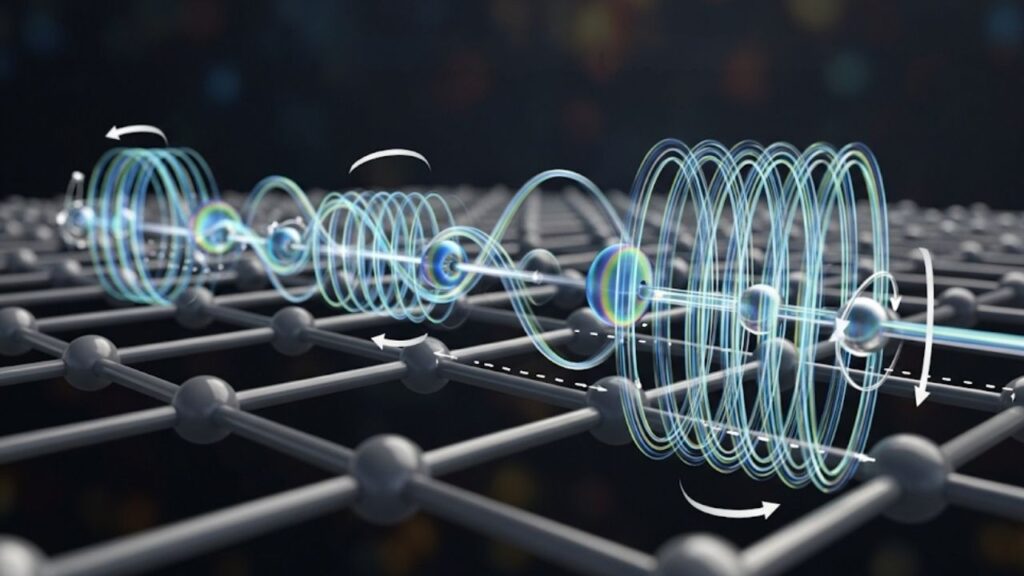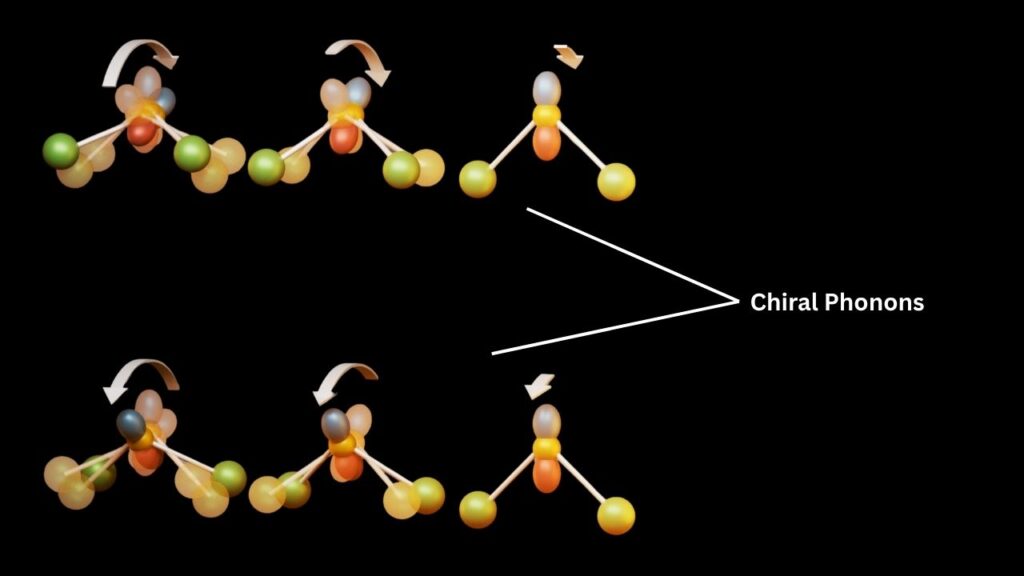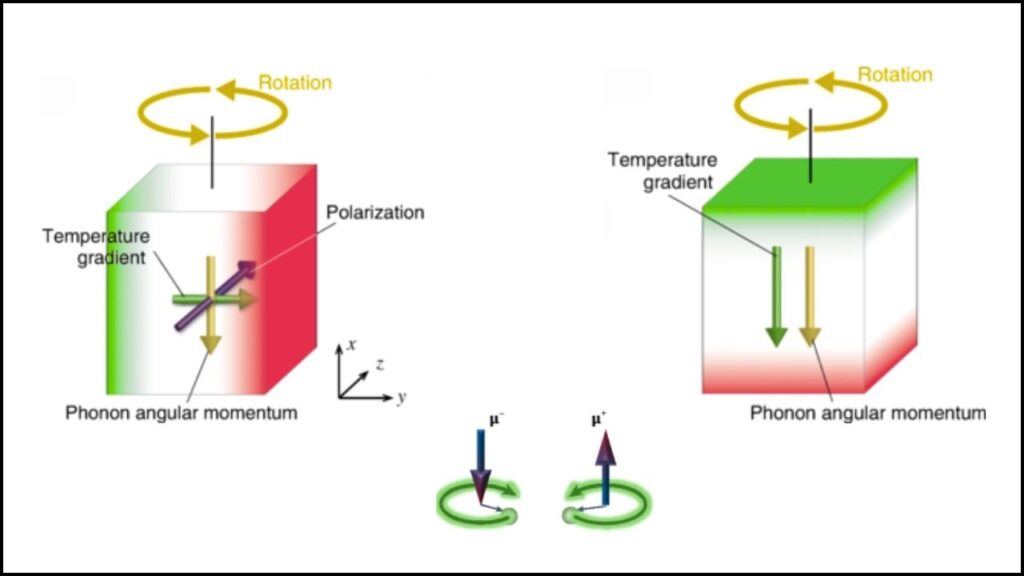Phonon angular momentum is reshaping how scientists think about the fundamental nature of solids, heat, and information transfer. For more than half a century, physicists believed that phonons—the quantum-mechanical waves that carry sound and heat—could only move back and forth, like a row of ants marching in a straight line. They were thought to lack angular momentum—the property that keeps a spinning top upright and allows planets to orbit the sun. But new experimental breakthroughs have turned that idea on its head: phonons can indeed carry angular momentum, and this discovery is opening up a new world of possibilities in quantum technology, materials science, and engineering.

Table of Contents
Why Does Phonon Angular Momentum Matter?
To understand why this is such a big deal, imagine you’re holding a jump rope and shaking it up and down. The waves travel along the rope, carrying energy from your hand to the other end. Now imagine you twist your hand gently as you shake the rope—now the waves not only move forward, but also rotate as they travel. This twisting, rotating motion is the essence of angular momentum. In solids, until recently, we thought the vibrations (phonons) could only move straight, not twist. But thanks to new research, we now know that phonons can twist too, and this property can be measured, controlled, and even used to design new kinds of technology.
This discovery matters to everyone. Whether you’re a student fascinated by how things work, a teacher explaining the universe, an engineer designing the next smartphone, or a scientist pushing the boundaries of quantum information, phonon angular momentum is a field to watch.
Phonon Angular Momentum
| Topic | Key Findings & Stats | Career & Professional Insights |
|---|---|---|
| Phonon Angular Momentum | Directly measured in chiral crystals (e.g., Tellurium); estimated torque ~10<sup>-11</sup> N·m at room temperature. | Quantum materials engineering, microelectronics R&D, spintronics, thermal management, phononics. |
| Measurement Technique | Cantilever-based device detects torque caused by thermal gradient in chiral crystals; effect vanishes in non-chiral samples. Experimental sensitivity at the nanomechanical level. | Growth in condensed matter physics, experimental techniques, materials characterization. |
| Applications | Potential for phonon-based quantum states, thermal and spin management, next-generation electronics, twistronics in 2D materials. | Careers in physics, engineering, computer science, device fabrication, and fundamental research. |
| Material Engineering | Twist engineering in layered materials (e.g., WSe₂) allows control of phonon properties for tailored thermal, electronic, and optical responses. | Materials science, nanofabrication, quantum device engineering. |
| Quantum Fluctuations | Even symmetric crystals show quantum-coherent angular momentum fluctuations, detectable with advanced spectroscopy. | Quantum theory, advanced instrumentation, fundamental research. |
The direct measurement of phonon angular momentum is a landmark in modern physics—one that bridges everyday experience with the deepest mysteries of quantum mechanics. It proves that even the smallest vibrations in matter can carry the seeds of rotation, and that by controlling these properties, we can engineer materials with truly novel capabilities. For professionals, this means new frontiers in quantum computation, spintronics, and materials engineering. For everyone, it’s a reminder that the universe is full of unexpected wonders, waiting to be discovered.
What Are Phonons and How Do They Work?
Phonons are the “particles” of sound and heat in solids. Every time you speak, listen to music, or feel something warm, you’re experiencing phonons in action. They’re created whenever atoms vibrate, and they carry energy through solids much like ocean waves carry energy through water.
For decades, scientists believed phonons could only carry energy and linear momentum. This meant that, as far as we knew, phonons influenced how heat spread, how sound traveled, and even how quickly a material could be deformed—but they couldn’t twist or rotate. Angular momentum—the property associated with spinning—was reserved for electrons, atoms, and other particles with clear rotational motion.

But new research has shown that this limitation doesn’t always hold. In certain kinds of materials, especially those with a twisty, “chiral” atomic structure, phonons can carry angular momentum. This means that when heat or sound travels through these materials, it can actually twist as it moves, like a corkscrew threading its way through a cork.
How Did Scientists Measure Phonon Angular Momentum?
The breakthrough came when researchers realized that chiral materials—materials with a distinct handedness, like a spiral staircase instead of a straight one—are the ideal place to look for phonon angular momentum.

If you heat one end of a chiral crystal and cool the other, the phonons moving from hot to cold can generate a twisting force, or torque, on the material.
To measure this tiny effect, scientists used a state-of-the-art setup involving a cantilever-based device—a delicate, microscopic seesaw that bends when a force is applied. They placed a chiral crystal (such as tellurium) between the hot and cold regions and watched as the cantilever twisted, responding to the torque created by the phonons. The effect disappeared in non-chiral materials, confirming that it was the special, twisty structure of the crystal that made the difference.
The torque measured was incredibly small—about a hundred-billionth of a newton-meter—but its implications are enormous. This was the first direct, macroscopic observation of phonon angular momentum in action.
Why Is Phonon Angular Momentum So Important?
For Fundamental Physics
Angular momentum is one of the most fundamental conserved quantities in nature. It explains why planets orbit, why gyroscopes balance, and why quantum particles have spin. Finding it in phonons means that even collective vibrations—not just individual particles—can participate in rotational motion at the atomic scale. This enriches our understanding of quantum mechanics and opens up new ways to describe the behavior of materials under extreme conditions.

For Technology and Engineering
Control over phonon angular momentum could lead to:
- Advanced Electronics: Devices that use phonon states for information storage and processing, complementing or even replacing electrons in some roles.
- Thermal Management: Materials that direct heat in specific, twisty paths—like “thermal circuits” that could cool down computer chips more efficiently.
- Quantum Sensors: New kinds of sensors that detect tiny twists and rotations at the atomic level, with applications from medical diagnostics to environmental monitoring.
- Spintronics: Hybrid devices where phonons and magnons (magnetic vibrations) interact, creating novel ways to manipulate information with both heat and magnetism.
For Materials Science
Researchers are already using twistronics—the science of twisting layered materials—to engineer phonon properties. By carefully stacking and twisting two-dimensional materials like tungsten diselenide (WSe₂), scientists can tune how phonons (and their angular momentum) behave. This allows for customized thermal, electronic, and optical responses—a major step toward “designer materials” for specific tasks.
Step-by-Step Guide to Understanding Phonon Angular Momentum
Step 1: Grasp the Basics
- Phonons are quantum-mechanical waves of vibration in solids.
- Angular momentum is a measure of how much an object spins or rotates.
- Chiral materials have a handedness, like a left- or right-handed screw.
Step 2: The Experimental Milestone
- Heat a chiral crystal at one end and cool the other.
- Phonons travel from hot to cold, carrying not just heat but also angular momentum.
- The momentum leads to a twisting force (torque) on the crystal.
- Measure the torque with a sensitive nanomechanical cantilever.
- Reverse the gradient or the crystal’s chirality: the torque reverses; use a non-chiral crystal: the effect vanishes.
Step 3: The Quantum Layer
- In ordinary, symmetric crystals, each phonon mode averages to zero angular momentum, but quantum fluctuations can create momentary, detectable twists.
- In chiral crystals, the angular momentum is real, measurable, and can be engineered.
Step 4: Practical Applications
- Engineer materials by twisting layers to control how phonons (and their angular momentum) behave.
- Couple phonons to magnons for hybrid quantum states useful in spintronics.
- Probe with advanced spectroscopy to detect and use subtle angular momentum effects.
New Quantum Material Reveals Hidden Metallic State for Ultra-Fast Electronics
Scientists Use Magnetic Chains and Superconductors to Create a New Quantum Material
FAQs About Phonon Angular Momentum
Q: What is a phonon, exactly?
A: A phonon is a quantum of vibration in a solid—a tiny “packet” of sound or heat energy that travels through the atomic lattice.
Q: How is phonon angular momentum different from electron spin?
A: Electron spin is an intrinsic property of individual electrons. Phonon angular momentum is a collective property of many atoms vibrating together in a pattern that twists as it moves.
Q: Why is this discovery important for everyday technology?
A: Because phonons are everywhere—any time you heat something or hear sound, phonons are involved. If we can control their twisting motion, we can design new kinds of electronics, sensors, and materials with properties not possible before.
Q: Can phonon angular momentum be used for quantum computing?
A: Potentially, yes. Phonon-based quantum states could serve as robust alternatives or complements to electronic qubits, especially in systems where phonons couple strongly to other quantum objects.
Q: Are there real-world materials where this effect is strong?
A: The effect is strongest in chiral crystals, like tellurium and certain layered materials. But even in more common crystals, quantum fluctuations can produce detectable effects at the microscopic level.
Q: What’s next for research in phonon angular momentum?
A: Scientists are now exploring how to couple phonon angular momentum to light, electrons, and magnons, and how to engineer materials for real-world devices. This is a vibrant, fast-moving field with many open questions and exciting opportunities.
Putting Phonon Angular Momentum to Work
For students and teachers, this discovery is a vivid example of how the universe always has new surprises, even in phenomena we thought we understood. For engineers and materials scientists, it’s a toolkit for inventing the next generation of smart materials and devices. For scientists and quantum researchers, it’s a gateway to new states of matter and information.
The bottom line: Phonons are not just messengers of heat and sound; they are also carriers of twist, rotation, and angular momentum. By learning to harness these quantum twists, we can imagine a future of materials and technologies that bend and turn at our command—bringing science fiction closer to reality, one vibration at a time.



















